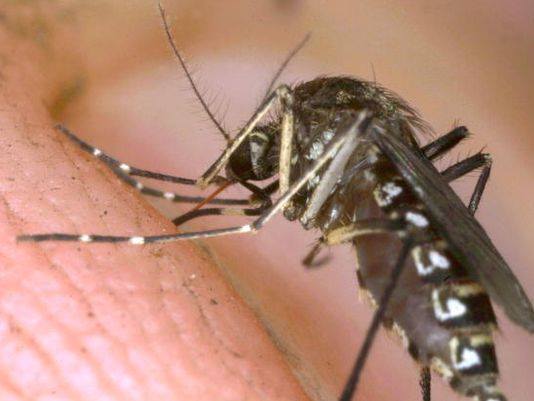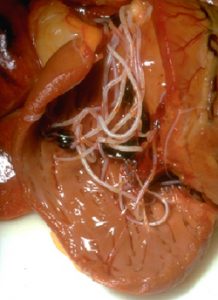Originally published on: Apr 25, 2014

Heartworm disease is a serious and eventually fatal condition caused by parasitic nematode (roundworm) living in the arteries of the lungs and the right side of the heart. Dogs are considered the primary host for heartworms (Dirofilaria immitis), however heartworms may infect more than 30 species of animals including coyotes, foxes, wolves and other wild canids, domestic cats and wild felids, ferrets, sea lions, etc. They can infect humans as well, although this is rare. Cases of canine heartworm disease have been reported in all 50 states, but are particularly endemic in the south and east portions of the USA from Texas to North Carolina.
What Causes Heartworm Disease?
 Heartworm disease is spread by infected mosquitos. A mosquito takes a blood meal from an infected animal and takes in blood containing the heartworm pre-larvae or microfilariae, pronounced: micro-fil-ar-ee-a. During the next 10 to 14 days, the microfilariae mature to the infective larval stage within the mosquito. These small, hair-like organisms can then be transmitted to other dogs by the same mosquito. It then takes a little over 6 months for the infective larvae to mature into adult heartworms. The mature worms then breed and release more microfilariae which can be transferred to other dogs via new mosquito bites. Those that remain develop, mature, breed and produce more new worms. These adult worms take up residence in the arteries of the heart and lungs, interfering with the operation of heart valves and blood flow through the lungs.
Heartworm disease is spread by infected mosquitos. A mosquito takes a blood meal from an infected animal and takes in blood containing the heartworm pre-larvae or microfilariae, pronounced: micro-fil-ar-ee-a. During the next 10 to 14 days, the microfilariae mature to the infective larval stage within the mosquito. These small, hair-like organisms can then be transmitted to other dogs by the same mosquito. It then takes a little over 6 months for the infective larvae to mature into adult heartworms. The mature worms then breed and release more microfilariae which can be transferred to other dogs via new mosquito bites. Those that remain develop, mature, breed and produce more new worms. These adult worms take up residence in the arteries of the heart and lungs, interfering with the operation of heart valves and blood flow through the lungs.
Symptoms and Detection
It can take 8 months to two years for observable symptoms to appear in an infected dog, and by that time the disease can be well advanced. Symptoms include a mild, persistent cough, reluctance to move about or exercise, fatigue after only moderate exercise, reduced appetite, fainting and weight loss. However, heartworm disease can be easily detected during your pet’s annual wellness examination by the veterinarian.
A small blood sample is taken and placed into an ELISA or SNAP test machine which detects antigens (proteins) produced by adult, female heartworms. This can catch the infestation even if the dog does not yet have any microfilariae in the bloodstream (approximately 20% of cases). Other detection methods include microscopic examination of the blood looking for microfilariae, other blood chemistry tests, ultrasound of the heart, X-ray of the heart, EKG or ECG. These methods require the presence of large numbers of adult worms for a positive diagnosis.
Treatment of Heartworm Disease
Once the worms are detected, it must be determined if the dog is healthy enough to withstand treatment. If the infestation is caught early, and if the dog has no other serious health issues, treatment should begin as soon as possible. The process used by the veterinarians we work with starts with a course of antibiotics for 30 to 45 days. Then a dose of Heartgard (or equivalent) to kill the microfilariae in the blood stream. Prednisone is also begun at this point to reduce fluid build-up and clogging of the lungs that can result as dead microfilariae get caught in the capillaries of the lungs.
Two weeks later the main treatment occurs: two injections of a medication containing Adulticide deep within the muscles of the lower back, one injection on each of two successive days. This is a painful procedure and the dog is generally sedated. Pain will persist for several days after treatment and pain medication may be needed.
Adulticide Therapy
There is currently only one drug approved by the FDA for use in dogs for the elimination of adult heartworms. This drug is an organic arsenical compound. Melarsomine dihydrochloride (Immiticide®, Merial) has demonstrated a higher level of effectiveness and safety than any other adult heartworm treatment previously available.
Pets are typically hospitalized for several days for this treatment and aftercare. At Piney Mountain Foster Care, this process has become our specialty. The veterinarians at the Dr. Carol Hood Memorial Animal Shelter in Newport Tennessee administer the medications and we provide the care needed before and after treatment and the close supervision required during recovery.
Heartworm Disease Recovery

Following the Adulticide treatment, the adult heartworms begin to die. The primary danger now is that large numbers of them will clog arteries to and in the dog’s lungs, making it difficult for them to oxygenate their blood. In severe cases, pulmonary embolisms (lesions in the lungs) may develop causing bleeding in the lung and potential for a collapsed lung. It is vitally important that the dog not be allowed to over-stress their lungs through rambunctious play. Following the main treatment the dog is crated. When let out for relief and fresh air they are kept on a leash and kept from frolicky playmates.
The dog’s body will absorb the tissue of the dead worms and the lungs will clear. If no damage was caused to the lungs, the dog will come out of treatment healthy and happy once again. If the infestation was severe before it was detected, the dog may have to live with heart damage such as an enlarged chamber, weakened muscle, or damaged valves. Even after the heartworms have been killed, these dogs may require lifetime treatment for heart failure. This includes the use of diuretics, heart medications such as ACE-inhibitors, beta-blockers or cardioglycosides, and special low-salt diets. Early detection and treatment is highly recommended.
Heartworm Prevention
Prevention of heartworm disease is easily accomplished through a variety of methods. The most popular is a monthly, chewable tablet that your dog will think is a treat. HeartwormSociety.org recommends these brands:
Ivermectin
Ivermectin (Heartgard® & Heartgard® Plus by Merial, Iverhart® Plus & Iverhart MAX™ by Virbac and Tri-Heart® Plus by Schering-Plough) was the first in this family of drugs to be approved for preventing heartworm infection. An infection with larvae as long as two months prior to the initiation of ivermectin treatment will be blocked from development.
You may visit their web site for recommendations on daily oral, topical and injectable alternatives. Also, talk with your veterinarian about what preventatives they recommend.
Heartworm preventatives are available through your veterinarian, most pet stores, many home center stores, farm supply stores as well as on-line. Preventatives are easy to get, inexpensive, and easy to administer. There is no reason to risk exposing your companion animal to this dreaded disease. Use a preventative year-round to insure they are not exposed.
Sources
- http://www.heartwormsociety.org/…canine-heartworm.html
- http://www.heartwormsociety.org/…heartworm.html
- http://www.vcahospitals.com/
- http://www.petmd.com/
| If you enjoy our updates, Doggy Tales, and educational articles consider subscribing for notices when new pieces are posted. It’s painless and you can unsubscribe any time you want. Your e-mail address is used ONLY to deliver these notices. | [email-subscribers namefield=”YES” desc=”” group=”Public”] |



